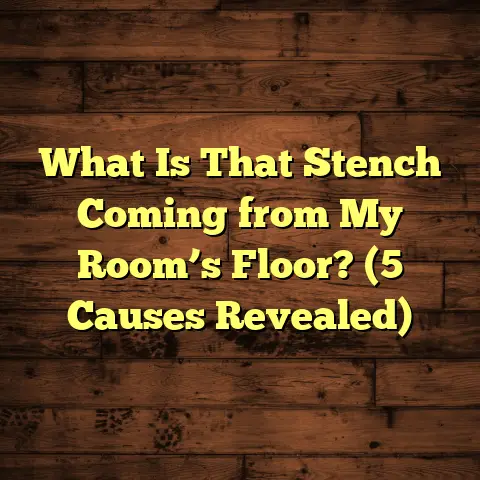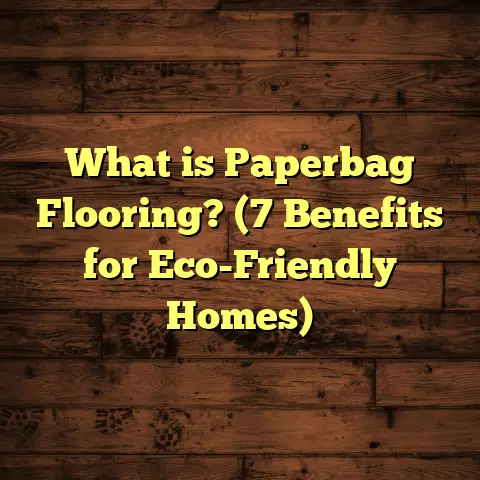What is Wood Plastic Composite Flooring? (5 Benefits You Must Know)
Warning: Choosing the wrong flooring for your home can
lead to serious headaches, unexpected costs, and a lot of
regret down the road. If you don’t want to deal with warping,
peeling, or constant maintenance, you better pick wisely.
I want to share with you everything I know about Wood
Plastic Composite (WPC) flooring. Over the years, I’ve worked
on dozens of projects using this material, and it’s become one
of my favorites for many reasons. So grab a cup of coffee,
and let’s explore this flooring option together in depth.
What is Wood Plastic Composite Flooring?
Wood Plastic Composite flooring is exactly what it sounds like:
a composite material made from wood fibers combined with
plastic polymers. These two components are fused to create
a plank or tile that looks like wood but performs differently.
This material originated as an innovation to solve problems
associated with traditional wood flooring, like moisture damage,
high maintenance, and cost. By blending wood with plastic,
manufacturers created a product that keeps wood’s aesthetic
appeal but adds water resistance, durability, and ease of care.
Let me break down the main parts of WPC flooring:
- Wood fibers or wood flour: These are finely ground wood
particles taken from sawdust or recycled wood products.
They give the composite its natural wood look and some of its
texture. - Plastic polymers: Usually PVC (polyvinyl chloride) or PE (polyethylene), this is the binding agent that holds the wood fibers together and adds flexibility and water resistance.
- Additives: To improve performance, manufacturers add UV stabilizers, anti-fungal agents, color pigments, and sometimes fire retardants.
- Wear layer: On top of the plank is a transparent layer made of urethane or aluminum oxide that protects the printed design layer underneath from scratches, stains, and wear.
How It’s Made
The manufacturing process involves mixing wood fibers with plastic pellets at high heat until they melt together into a thick paste. This mixture is then pushed through an extrusion machine that forms planks or tiles.
After shaping, the planks cool and harden before receiving the printed design layer and protective wear coat applied on top.
What’s fascinating is that this process allows for consistent quality control and mass production at a relatively low cost compared to solid hardwood. The printed layer can mimic a wide variety of wood species—from oak to walnut to exotic tropical woods—without the environmental impact of harvesting actual trees.
Why I Started Using WPC Flooring
Years ago, I was called to fix a customer’s basement where hardwood floors had swollen and warped after a minor flood. They were frustrated because each time they replaced the floors, moisture problems caused the same issue again.
I suggested trying WPC flooring for its water-resistant core and easy installation. The client was skeptical but agreed.
After installation, the floors remained pristine despite occasional water seepage in the basement during heavy rains.
That experience convinced me that WPC flooring could solve many common problems for homeowners struggling with moisture or durability issues.
5 Benefits of Wood Plastic Composite Flooring You Must Know
Now that you understand what WPC flooring is, let me share five key benefits I’ve seen firsthand in my work.
1. Exceptional Water Resistance
Water damage is the number one enemy of hardwood floors.
Imagine spilling a glass of wine or dropping a wet mop on your hardwood floor—within hours or days, you might see warping, discoloration, or mold growth.
WPC floors have a core made mostly of plastic combined with wood fibers. This core resists swelling because plastic doesn’t absorb water like wood does.
In fact, tests by flooring manufacturers show that WPC planks can withstand standing water for up to 72 hours without damage—far surpassing laminate or traditional hardwood.
In one project I worked on involving a kitchen renovation, the client was nervous about installing wood-like flooring near sinks and dishwashers. WPC was perfect because it tolerated occasional spills without staining or warping.
How Does WPC Compare to Other Floors?
Here’s a quick comparison based on water resistance:
| Flooring Type | Water Resistance Level | Notes |
|---|---|---|
| Hardwood | Low | Warps/swallows quickly with moisture |
| Laminate | Moderate | Resists splashes but vulnerable to standing water |
| Vinyl (LVP/WPC) | High | Can handle spills and moisture well |
| Tile | Very high | Waterproof but cold/hard underfoot |
WPC sits close to vinyl in terms of moisture handling but looks much more like authentic wood.
2. Simple and Fast Installation
If you’ve ever installed hardwood or even some laminates yourself, you know it can be complicated and time-consuming.
WPC flooring simplifies installation thanks to its click-lock system that fits planks tightly without glue or nails.
I recall a renovation where we installed 1,200 square feet of WPC flooring in just three days—half the time it would take for traditional hardwood.
This fast turnaround not only cuts labor costs but also reduces disruption if you’re living in the space during installation.
Additionally, WPC planks are dimensionally stable—meaning they don’t expand or contract much with temperature or humidity changes—so there’s no need for long acclimation periods before laying them down.
How I Use FloorTally for Installation Planning
For every job, accurate material estimation is key. I rely on FloorTally to calculate how many boxes of WPC flooring I need based on room dimensions and waste factors.
It factors in local labor costs too, helping me give clients realistic budgets upfront without surprises later.
Using this tool prevents ordering too much material—which can be costly—or too little—which causes delays waiting for restocks.
3. Durable Surface and Scratch Resistance
Homes aren’t always gentle environments—kids running around, pets scratching floors, furniture being moved—these all take their toll on flooring surfaces.
I once worked on a house where the family had two large dogs whose nails scratched up their laminate flooring within months.
WPC floors feature a tough wear layer made of urethane and aluminum oxide particles that protect against scratches better than most laminates or hardwoods.
According to independent lab tests, WPC floors score between 6 and 9 on the Mohs scale of hardness (where diamond scores 10), making them suitable for high-traffic spaces.
This durability means less worry about daily wear and tear and fewer repairs or replacements over time.
4. Comfortable Underfoot and Noise Reduction
Think about how some floors feel hard and cold beneath your feet—especially tile or vinyl that lacks any cushioning.
WPC’s composite core offers a slight softness and warmth underfoot because it contains both wood fibers and plastic polymers.
I had a client who mentioned how much more comfortable their kitchen felt after switching from tile to WPC flooring—they could stand for longer without fatigue.
Moreover, WPC floors reduce sound transmission better than laminate or hardwood due to their dense core structure combined with underlayment materials.
In apartment buildings or multi-story homes, this noise reduction helps keep footsteps quieter for neighbors below.
5. Low Maintenance Saves Time and Money
Nobody enjoys spending hours cleaning floors every week or worrying about damaging them with incorrect products.
WPC floors only require regular sweeping or vacuuming plus occasional damp mopping with mild detergent.
The protective wear layer resists stains from everyday spills—coffee, juice, red wine—and wipes clean easily without leaving marks.
Compared to hardwood’s need for polishing and refinishing every few years or laminate’s vulnerability to water damage during mopping, WPC is much more forgiving.
From my experience managing rental properties with WPC floors, tenants appreciate how little effort they need to put into upkeep—which reduces complaints and maintenance calls significantly.
Digging Deeper: Data & Research on WPC Flooring
I’ve pulled together some relevant numbers from industry reports and studies that highlight why WPC stands out:
- According to the Flooring Industry Association, sales of WPC flooring grew by over 40% between 2017 and 2022 in North America alone—a sign of growing trust in its performance.
- A lab study by Material Science Journal showed that WPC composites retain over 95% of their flexural strength after immersion in water for 30 days—compared to less than 70% for traditional wood composites.
- Environmental impact assessments suggest that using recycled wood fiber in WPC reduces demand on virgin timber by up to 60%, helping conserve forests while offering consumers a durable product.
- In terms of lifespan, many manufacturers provide warranties ranging from 15 to 25 years depending on use conditions—similar to mid-range hardwood but with lower upkeep costs.
Real-World Case Studies From My Work
Case Study 1: Flood-Proof Basement Makeover
Client: Family needed waterproof flooring after repeated basement floods damaged their carpet twice in two years.
Challenge: Find attractive flooring that wouldn’t warp or grow mold after water intrusion.
Solution: Installed WPC flooring with moisture barrier underlayment.
Outcome: More than two years post-installation with multiple rainstorms—no visible damage or moisture problems reported.
Client Feedback: “We love how warm it feels compared to tile and no worries about spills or dampness.”
Case Study 2: Busy Household with Pets
Client: Homeowners with three dogs wanted scratch-resistant flooring for living room and hallways.
Challenge: Find flooring durable enough to survive pet claws without losing natural wood look.
Solution: Selected high-grade WPC planks with thick wear layer designed for commercial use.
Outcome: After 18 months of heavy foot traffic and pet activity—floors remain scratch-free with minimal cleaning needed.
Client Feedback: “We can relax about our dogs running inside now without stressing about scratches.”
Case Study 3: Kitchen Renovation in Humid Climate
Client: Homeowner renovating kitchen sought wood-look floor tolerant of humidity spikes from cooking steam and spills.
Challenge: Avoid hardwood because of moisture concerns; want easy cleanup surface.
Solution: Installed waterproof WPC flooring that looks like oak with textured finish for grip.
Outcome: After one year—floor still looks brand new; no curling or staining despite daily use.
Client Feedback: “The floor feels great underfoot and handles kitchen messes perfectly.”
Cost Considerations: What You Need to Know
Pricing for WPC flooring varies by quality, brand, plank thickness, installation complexity, and region. Here’s a general idea based on recent projects:
| Cost Component | Price Range (per sq ft) | Notes |
|---|---|---|
| Material | $2.50 – $5.00 | Higher-end brands cost more |
| Installation Labor | $1.50 – $3.00 | Depends on location & job size |
| Underlayment | $0.30 – $0.80 | Often included but varies |
| Additional Supplies | $0.20 – $0.50 | Adhesives, trims, transition strips |
Total installed costs generally run between $4 – $8 per square foot depending on choices made.
Using tools like FloorTally allows me to quickly generate detailed cost estimates based on exact room measurements plus local labor rates. This helps clients budget confidently before committing.
Comparing WPC Flooring With Other Popular Options
I often get asked how WPC stacks up against alternatives like laminate, vinyl plank (LVP), engineered hardwood, or solid hardwood:
| Feature | WPC Flooring | Laminate | LVP Vinyl Plank | Engineered Hardwood | Solid Hardwood |
|---|---|---|---|---|---|
| Water Resistance | High | Moderate | Very High | Low | Low |
| Installation Ease | Easy (click-lock) | Easy | Easy | Moderate | Difficult |
| Scratch Resistance | High | Moderate | Moderate | Moderate | Low–Moderate |
| Comfort Underfoot | Good | Fair | Fair | Good | Good |
| Maintenance | Low | Low | Low | High | High |
| Appearance | Very realistic wood | Good | Good | Excellent (real wood) | Excellent (real wood) |
| Cost | Mid-range | Low–Mid | Low–Mid | High | Highest |
Frequently Asked Questions About WPC Flooring
Q: Can I install WPC flooring myself?
A: Yes! Thanks to click-lock systems and no need for glue/nails, many DIYers find it manageable with basic tools. Just measure carefully and follow instructions closely.
Q: Is WPC environmentally friendly?
A: Partially yes—it uses recycled wood fibers reducing virgin timber demand but involves plastic polymers which are petroleum-based. Overall impact depends on manufacturer practices.
Q: Can I install WPC over radiant heating?
A: Most manufacturers approve installation over radiant heat systems, but check product specs because excessive heat can damage some composites.
Q: How do I clean WPC floors?
A: Regular sweeping/vacuuming plus occasional damp mopping with mild detergent is enough. Avoid harsh chemicals or soaking water.
Q: Does WPC fade in sunlight?
A: Quality brands include UV inhibitors in the wear layer reducing fading; however prolonged direct sunlight may still cause some color changes over time.
Final Thoughts From My Experience
Choosing your floor isn’t just about looks—it affects your comfort, maintenance time, durability over years, and even your home’s resale value.
WPC flooring impressed me as a practical solution that balances natural beauty with modern performance needs. It’s especially useful if you want wood aesthetics without worrying about moisture damage or extensive upkeep.
If you want help estimating costs or deciding if it fits your space, just ask—I’m happy to share insights based on real projects I’ve handled over the years.
Remember: Your floor supports every step you take at home—make sure it’s strong enough for your journey!





